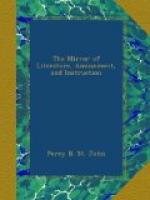It was not intended as a tribute to the Pope, but chiefly for the support of the English school, or college, at Rome. The popes, however, shared it with the college, and at length found means, to appropriate it to themselves.
At first it was only an occasional contribution; but it became at last a standing tax, being established by the laws of King Canute, Edward the Confessor, the Conqueror, &c. The bishops, who were charged with the collecting it, employed the rural deans and archdeacons therein.
Edward III. first forbade the payment; but it soon after returned, and continued till the time of Henry VIII., when Polydore Virgil resided here as the Pope’s receiver general. It was abolished under that prince, and restored again under Philip and Mary; but it was finally prohibited under Queen Elizabeth.
WALTER E.C.
* * * * *
POPISH RELICS.
Ere the bright dawn of the Reformation lighted upon England, the furniture of churches appears, from ancient records, to have been of a splendid description; and vast sums are stated to have been lavished upon the images of saints, &c. Great Saint Mary’s Chapel, Cambridge, is in the possession of an inventory of the goods and chattels possessed by that ancient edifice in the 19th year of Henry VII., of which the following is a transcript:—
“Item—A coat of tawney damask, purfled with velvet, appertaining to our Lady.
“Item—A coat for her son, of the same satin, purfled with black velvet, and spangled with gold.
“Item—A relic, called a box of silver with the oil of St. Nicholas.
“Item—Another little box of silver, with a bone of St. Lawrence.
“Item—A shoe of silver for the image of our Lady, and a piece of a penny, weighing in all two ounces in a box.
“Item—An image of our Lady and her Son, of copper and gilt, with a chrystal stone.
“Item—A collar of gold for to hang about our Lady’s neck, of nine links in the collar.
“Item—A cap of black velvet, with fine pearl, for our Lady’s son.
“Item—Two maces for St. Edmund.
“Item—Three small crowns for St. Katherine.
“Item—A cross and staff for St. Nicholas.”
The orthography of this extract has been modernized, but the idiom (if any) has been retained.
JUVENIS.
* * * * *




